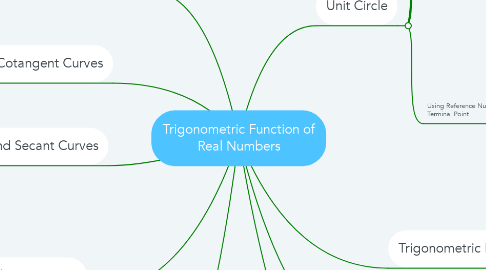
1. Sine and Cosine Curves
1.1. y = a sin kx and y = a cos kx (k > 0)
1.2. have amplitude | a |
1.3. Period 2π / k
2. Periodic Properties
2.1. The functions tangent and cotangent have period π
2.1.1. tan (x + π) = tan x
2.1.2. cot (x + π) = cot x
2.2. The functions cosecant and secant have period 2π
2.2.1. csc (x + 2π) = csc x
2.2.2. sec (x + 2π) = sec x
3. Tangent and Cotangent Curves
3.1. y = a tan kx and y = a cot kx (k > 0)
3.2. Period π / k
4. Cosecant and Secant Curves
4.1. y = a csc kx and y = a sec kx (k > 0)
4.2. Period 2π / k
5. Simple Harmonic Motion
5.1. If the equation describing the displacement y of an object at time t is
5.2. y = a sin wt or y = a cos wt
5.3. then the object is in SIMPLE HARMONIC MOTION
5.4. Amplitude = | a |
5.5. Period = 2π / w
5.6. Frequency = w / 2π
6. Unit Circle
6.1. Its equation is x^2 + y^2 = 1
6.2. Definition: the circle of radius 1 centered at the origin in the xy-plane.
6.3. Terminal Point
6.3.1. Mark off a distance t along the unit circle, starting at the point (1,0) and moving in a counterclockwise direction if t is positive or in a clockwise direction if t is negative. In this way we arrive at a point P(x, y) on the unit circle. The point P(x, y) is called the terminal point.
6.4. Reference Number
6.4.1. Let t be a real number. The reference number t associated with t is the shortest distance along the unit circle between the terminal point determined by t and the x-axis.
6.5. Using Reference Number to find the Terminal Point
6.5.1. 1. Find the reference number t
6.5.2. 2. Find the terminal point Q(a, b) determined by t
6.5.3. 3. The terminal point determined by t is P(a, b), where the signs are chosen according to the quadrant in which the point lies
7. Trigonometric Functions
7.1. sin t = y
7.1.1. csc t = 1 / y (y ≠ 0)
7.2. cot t = y
7.2.1. sec t = 1 / x (x ≠ 0)
7.3. tan t = y / x
7.3.1. cot t =x / y (y ≠ 0)
8. Even-Odd Properties
8.1. sin (-t) = -sin t
8.1.1. csc (-t) = -csc t
8.2. cos (-t) = -cos t
8.2.1. sec (-t) = -sec t
8.3. tan (-t) = -tan t
8.3.1. cot (-t) = -cot t
9. Fundamental Identities
9.1. Reciprocal Identities
9.1.1. csc t = 1 / sin t
9.1.1.1. tan t = sin t / cos t
9.1.2. sec t = 1 / cos t
9.1.2.1. cot t = cos t / sin t
9.1.3. cot t = 1 / tan t
9.2. Pythagorean Identities
9.2.1. sin^2 t + cos^2 t = 1
9.2.2. tan^2 t + 1 = sec^2 t
9.2.3. 1 + cot^2 t = csc^2 t

